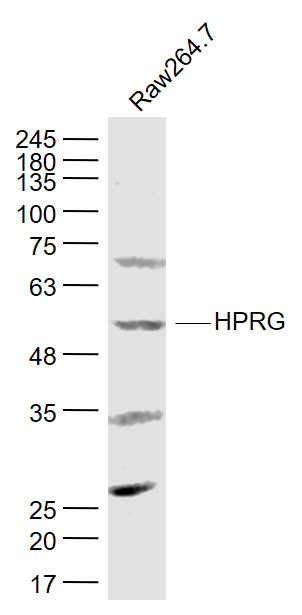
Rabbit Anti-HPRG antibody
Histidine proline rich glycoprotein; Histidine rich glycoprotein; HRGP; Thrombophilia due to elevated HRG.
View History [Clear]
Details
Product Name HPRG Chinese Name 组氨酸富含脯氨酸glycoprotein抗体 Alias Histidine proline rich glycoprotein; Histidine rich glycoprotein; HRGP; Thrombophilia due to elevated HRG. Research Area Cardiovascular Growth factors and hormones Immunogen Species Rabbit Clonality Polyclonal React Species Mouse, (predicted: Human, Rat, ) Applications WB=1:500-2000 ELISA=1:5000-10000 IHC-P=1:100-500 IHC-F=1:100-500 IF=1:100-500 (Paraffin sections need antigen repair)
not yet tested in other applications.
optimal dilutions/concentrations should be determined by the end user.Theoretical molecular weight 58kDa Cellular localization Secretory protein Form Liquid Concentration 1mg/ml immunogen KLH conjugated synthetic peptide derived from human HPRG/HRG: 75-180/525 Lsotype IgG Purification affinity purified by Protein A Buffer Solution 0.01M TBS(pH7.4) with 1% BSA, 0.03% Proclin300 and 50% Glycerol. Storage Shipped at 4℃. Store at -20 °C for one year. Avoid repeated freeze/thaw cycles. Attention This product as supplied is intended for research use only, not for use in human, therapeutic or diagnostic applications. PubMed PubMed Product Detail HRG contains two cystatin-like domains and is located in plasma and platelets. The physiological function is not yet known. It binds heme, dyes and divalent metal ions. It can inhibit rosette formation and interacts with heparin, thrombospondin, and the lysine-binding site of plasminogen. A potential prothrombotic effect of HRG is indicated by the inhibition of fibrinolysis and the reduction of inhibition of coagulation. Mutations in HRG lead to thrombophilia due to abnormal histidine-rich glycoprotein levels.
Function:
Plasma glycoprotein that binds a number of ligands such as heme, heparin, heparan sulfate, thrombospondin, plasminogen, and divalent metal ions. Binds heparin and heparin/glycosaminoglycans in a zinc-dependent manner. Binds heparan sulfate on the surface of liver, lung, kidney and heart endothelial cells. Binds to N-sulfated polysaccharide chains on the surface of liver endothelial cells. Inhibits rosette formation. Acts as an adapter protein and is implicated in regulating many processes such as immune complex and pathogen clearance, cell chemotaxis, cell adhesion, angiogenesis, coagulation and fibrinolysis. Mediates clearance of necrotic cells through enhancing the phagocytosis of necrotic cells in an heparan sulfate-dependent pathway. This process can be regulated by the presence of certain HRG ligands such as heparin and zinc ions. Binds to IgG subclasses of immunoglobins containing kappa and lambda light chains with different affinities regulating their clearance and inhibiting the formation of insoluble immune complexes. Tethers plasminogen to the cell surface. Binds T-cells and alters the cell morphology. Modulates angiogenesis by blocking the CD6-mediated antiangiongenic effect of thrombospondins, THBS1 and THBS2. Acts as a regulator of the vascular endothelial growth factor (VEGF) signaling pathway; inhibits endothelial cell motility by reducing VEGF-induced complex formation between PXN/paxillin and ILK/integrin-linked protein kinase and by promoting inhibition of VEGF-induced tyrosine phosphorylation of focal adhesion kinases and alpha-actinins in endothelial cells. Also plays a role in the regulation of tumor angiogenesis and tumor immune surveillance. Normalizes tumor vessels and promotes antitumor immunity by polarizing tumor-associated macrophages, leading to decreased tumor growth and metastasis.
Subunit:
Interacts (via the HRR domain) with TPM1; the interaction appears to contribute to the antiangiogenic properties of the HRR domain. Interacts with THBS2; the interaction blocks the antiangiogenic effect of THBS2 with CD36 (By similarity). Interacts with THBS1 (via the TSP type I repeats); the interaction blocks the antiangiogenic effect of THBS1 with CD3. Interacts with PLG (via its Kringle domains); the interaction tethers PLG to the cell surface and enhances its activation. Interacts with HPSE; the interaction is enhanced at acidic pH, partially inhibits binding of HPSE to cell surface receptors and modulates its enzymatic activity. Interacts (via the HRR domain) with TMP1; the interaction partially mediates the antiangiogenic properties of HRG. Interacts with kappa and lambda light chains of IgG molecules. Interacts with ATP5A1; the interaction occurs on the surface of T-cells and alters their cell morphology in concert with CONA. Binds IgG molecules containing kappa and lambda light chains and inhibits the formation of insoluble immunoglobulin complexes. Interacts with F12; the interaction, which is enhanced in the presence of zinc ions and inhibited by heparin-binding to HRG, inhibits factor XII autoactivation and contact-initiated coagulation.
Subcellular Location:
Secreted.
Tissue Specificity:
Expressed in macrophages and in malignant cells. Expressed by the liver and secreted in plasma (at protein level).
Post-translational modifications:
Proteolytic cleavage produces several HRG fragments which are mostly disulfide-linked and, therefore, not released. Cleavage by plasmin is inhibited in the presence of heparin, zinc ions or in an acidic environment. Cleavage reduces binding of HRG to heparan sulfate, but enhances the ability of HRG to bind and tether plasminogen to the cell surface. On platelet activation, releases a 33 kDa antiangiogenic peptide which encompasses the HRR. Also cleaved in the C-terminal by plasmin.
N-glycosylated.
DISEASE:
Defects in HRG are the cause of thrombophilia due to histidine-rich glycoprotein deficiency (THPH11) [MIM:613116]. A hemostatic disorder characterized by a tendency to thrombosis.
Similarity:
Contains 2 cystatin domains.
SWISS:
P04196
Gene ID:
3273
Database links:Entrez Gene: 3273 Human
Omim: 142640 Human
SwissProt: P04196 Human
Unigene: 1498 Human
Product Picture
References (0)
No References
Bought notes(bought amounts latest0)
No one bought this product
User Comment(Total0User Comment Num)
- No comment



 +86 571 56623320
+86 571 56623320
 +86 18668110335
+86 18668110335

